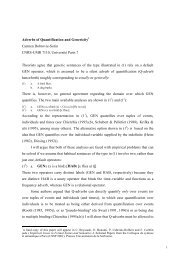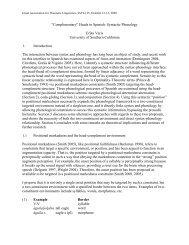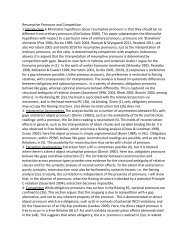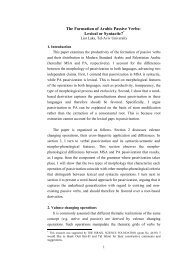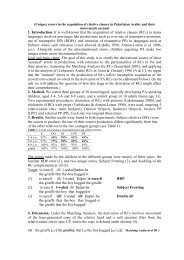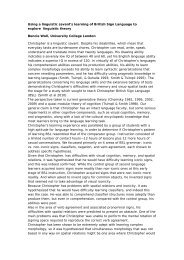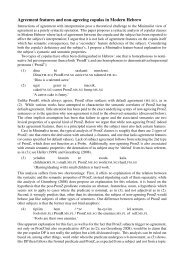paper
paper
paper
You also want an ePaper? Increase the reach of your titles
YUMPU automatically turns print PDFs into web optimized ePapers that Google loves.
PHON phon ¡<br />
£¥¤¤¤¤¤¤¤¤<br />
¦<br />
most intriguing fact is that they exhibit a number of features not found in other withconstructions:<br />
the order of the constituents with respect to their person specification is<br />
unique; an IPPC cannot be substituted with an equivalent coordinate phrase. Since IPPCs<br />
pattern neither with coordinate comitatives nor with comitative adjunction, we assume that<br />
the plural pronouns that occur in such structures are heads that select with-phrases with<br />
particular specifications. Such an assumption requires some additional modification of the<br />
hierarchy of nominal objects. According to this hierarchy, pronouns can be transitive and<br />
intransitive. In Russian, transitive prounouns are plural and select a PP complement, and<br />
therefore, will be treated as transitive 13 :<br />
¢<br />
(63)<br />
nom obj<br />
npro<br />
pron<br />
non com nom<br />
com nom<br />
ana<br />
ppro<br />
pro i<br />
pro tr<br />
(64)<br />
¡¡¡¡¡¡¡¡<br />
¢<br />
CAT¢<br />
HEAD noun<br />
VAL COMPS PP ¢ ¡<br />
CONTENT ¢ ¦¥¤ ¤©¦ INDEX¤<br />
<br />
¡<br />
£<br />
¦<br />
13 Notice that transitive pronouns exist in some languages, e.g. Cayuga, an Iroquoian language.



